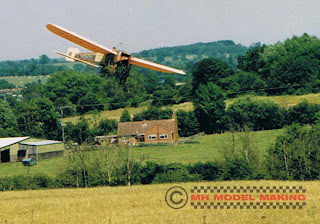The following pictures show close-up shots of the rear cockpit. Again, information on the full size Bleriot was hard to find so I used details from other aircraft of the same period.
The rear cockpit forward of the seat showing duck-board and control cables.
The grey panel in the picture is the back of the front cockpit bulkhead. The control cables seen passing through this grey panel are for the rudder and elevator controls. The 'duck-board' in the foreground is a foot rest for the pilot. The 2 small tubes coming from the grey panel at the bottom centre are for the 'bomb drop' cable to pass through. The entire area has also been 'dirtied up' a little to give it that 'used' look.
Aerial view of rear cockpit.
The plywood seat is similar to that used for the front cockpit but it has been cut down in height. The 'duck-board' can also be seen. The majority of the rear cockpit detail was constructed from 'liteply' and balsa wood to keep the weight down. The leather cockpit trim can also be seen, this is made in the same way as that used for the front cockpit (see Part 4 post for Front Cockpit description)
Rear cockpit leather trim close-up.
As the leather trim around the rear cockpit is in a 'U' shape it was necessary to taper each end. This was achieved buy sewing in a dart to obtain the correct taper. This trim was held in place using the same method as that used for the front cockpit, with eyelets and thread. Again, the thread was stained to help it blend in with the 'weathered' fuselage.
Close-up of rear seat. Cross bracing can also be seen.
If you look closely you can see 4 very small 'eye-hooks' on the starboard side of the fuselage under the seat. The receiver aerial wire passed through these 'eye-hooks' to keep the wire in place during flight.
Another close-up of the rear seat and support.
Close-up taken under the rear seat showing the dummy reserve fuel
tank in place. The tank was fixed to the front seat rear bulkhead.
The dummy reserve fuel tank filler cap.
The filler cap is situated just behind the front cockpit opening.
Another close-up of the dummy fuel tank,
taken when the model was finished.
This picture of the dummy fuel tank
was taken before the fuselage sides were covered.
The finished dummy fuel tank prior to installation.
The basic construction of the dummy fuel tank was made from .25mm thick plastic card (HIPS - styrene sheet) A tube was rolled to form the centre section of the tank. The domed ends were made using heat and a simple 'plug' former. This method results in a formed part without using a 'vacuum forming' machine.
When the basic construction was finished the tank could be detailed. A thin strip of plastic card was wrapped around each domed end were it joined the centre section tube. This thin strip was to simulate a 'flange'.
A plastic tube was glued to the top of the dummy fuel tank, this was to attach the filler cap to later, also made from plastic card.The other pipes visible were made from aluminium tube and wire. The support bracket for the large tube at the bottom of the tank was made from very thin aluminium sheet (litho plate). The 'wrap-round' straps that hold the tank to the bulkhead were also fabricated from thin aluminium sheet. Holes were drilled in this strap to add some scale detail and a strip of plastic card painted black represented a 'rubber' gasket between the bracket and tank.
The 'sight tube' to the left of the tank was made from 2 short pieces of aluminium wire bent at right angles. 2 holes were drilled through the tank and the right angled pieces of wire glued in place. After the tank was painted a short length of clear plastic tubing was placed between each piece of wire. The clear tube was also painted inside to give the illusion that there was fuel in the tank and tube.
The finished tank was painted to look like copper and 'weathered' All the seams and bracket fixings etc. were outlined with silver paint so they look like soldered joints.
Undercarriage photographs to follow...
To be continued...

























































